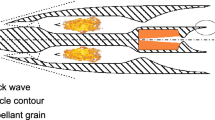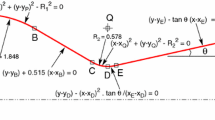Abstract
The development region of a free round turbulent jet was experimentally investigated in order to determine the dependence of the jet development on the exit conditions. In particular the influence of the exit conditions on the entrainment rate in both the axisymmetrix mixing layer region and at a distance of 20D from the nozzle was investigated.
The entrainment rate at 20D depends noticeably on the exit boundary layer state, i.e. laminar or turbulent, and on the turbulence intensity of the core. A laminar exit boundary layer showed the highest value of entrainment rate. A turbulent one reduced the entrainment rate at 20D by 15%. A grid placed at the nozzle exit, in order to increase the turbulence intensity of the core, reduced the entrainment rate at 20D by 40%. It must be mentioned that this grid also disturbed the exit boundary layer.
An empirical relation for the entrainment rate at the end of the mixing layer region as a function of the mixing layer parameters, is successful in predicting the entrainment rate at 20D within an accuracy of 5%. This result suggests a strong dependence of the jet development region on mixing layer processes, i.e. the development of organized structures and their coalescence. Possibly there is no asymptotic region which is fully independent of the mixing layer processes, and which is not more or less influenced by the exit conditions via the influence on these processes.
Similar content being viewed by others
References
Boguslawski L and Popiel CzO (1978) J Fluid Mech 90:111
Bradshaw P (1966) J Fluid Mech 26:225
Crow SC and Champagne FH (1971) J Fluid Mech 48:547
Hasan MAZ and Hussain AKMF (1982) J Fluid Mech 115:59
Hill BJ (1972) J Fluid Mech 51:773
Hinze JO and van der Hegge Zijnen BG (1949) Appl Sci Res A1:435
Hinze JO (1975) Turbulence. McGraw-Hill, Inc
Husain, ZD and Hussain AKMF (1979) AIAA J 17:48
Hussain AKMF and Clark AR (1977) Phys Fluids 20:1416
Hussain AKMF and Zedan MF (1978) Phys Fluids 21:1100
Hussain AKMF and Zedan MF (1978) Phys Fluids 21:1475
Ricou FP and Spalding DB (1961) J Fluid Mech 11:21
Roshko A. (1972) AIAA J 14:1349
Schlichting H (1951) Grenzschicht-Theorie. Verlag und Druck G. Braun
Tennekes H and Lumley JL (1972) A first course in turbulence. Massachusetts Institute of Technology Press
Townsend AD (1956) The structure of turbulent shear flow. Cambridge University Press
Wille R (1963) Z. Flugwiss 11:222
Wygnanski I and Fiedler H (1969) J Fluid Mech 38:577
Yule AJ (1978) J Fluid Mech 89:413
Zaman KBMQ and Hussain AKMF (1980) J Fluid Mech 101:449
Author information
Authors and Affiliations
Rights and permissions
About this article
Cite this article
Fondse, H., Leijdens, H. & Ooms, G. On the influence of the exit conditions on the entrainment rate in the development region of a free, round, turbulent jet. Appl. Sci. Res. 40, 355–375 (1983). https://doi.org/10.1007/BF00383041
Issue Date:
DOI: https://doi.org/10.1007/BF00383041




